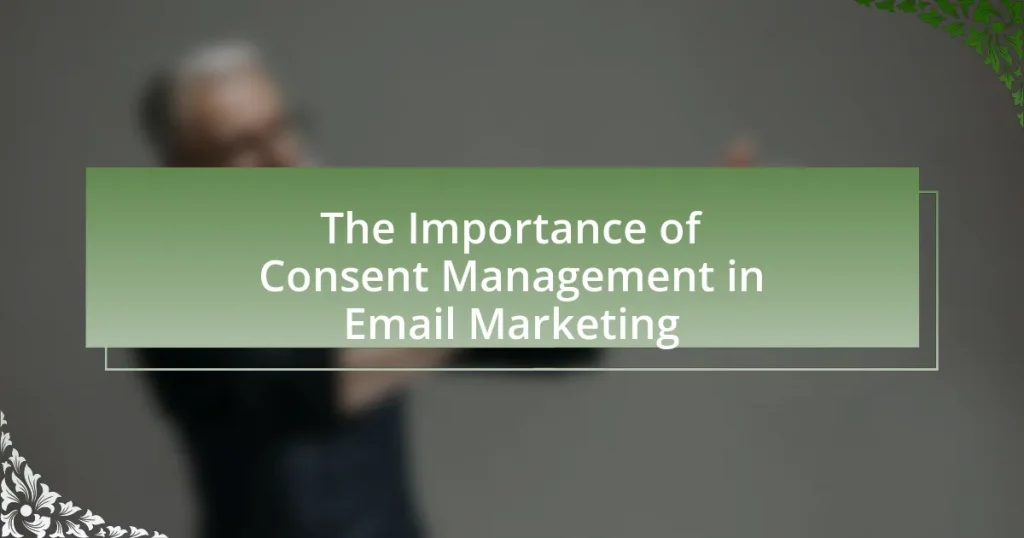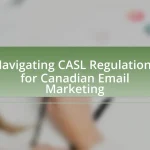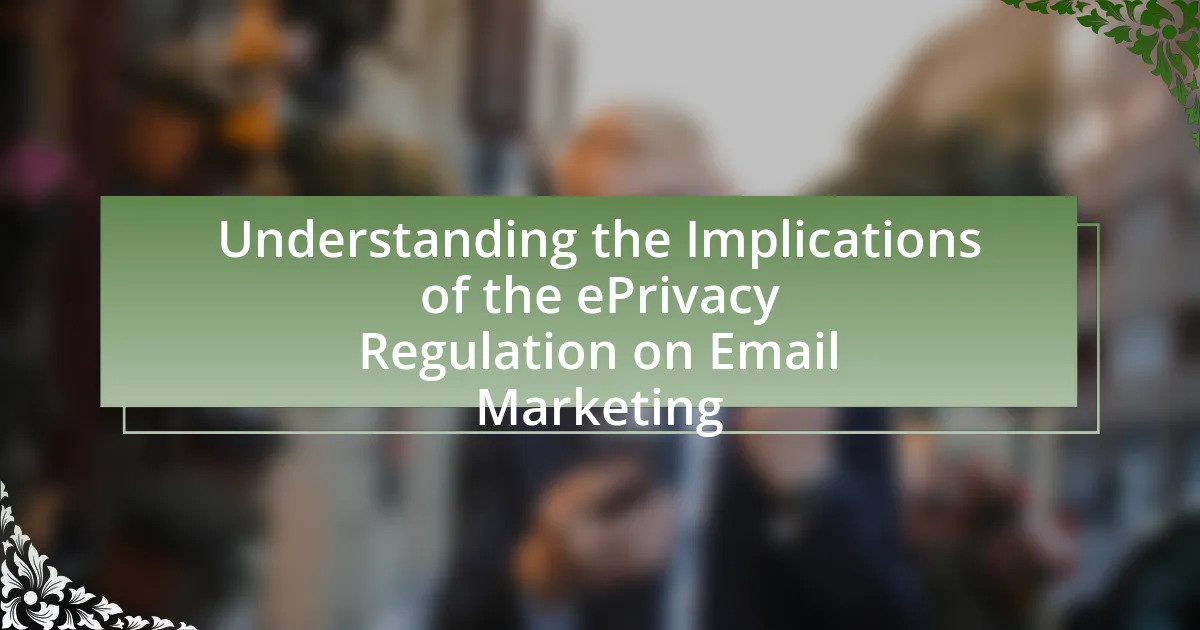Consent management in email marketing is the process of obtaining, tracking, and managing permissions from individuals to receive marketing communications, ensuring compliance with regulations such as GDPR and the CAN-SPAM Act. This practice is crucial for building consumer trust and avoiding legal repercussions, as explicit consent is required before sending promotional emails. Key components of effective consent management include transparency, user control, and proper documentation, while challenges such as compliance and technological integration must be addressed. The article explores the impact of consent management on email marketing campaigns, engagement rates, and deliverability, as well as best practices and tools for businesses to implement effective consent strategies.
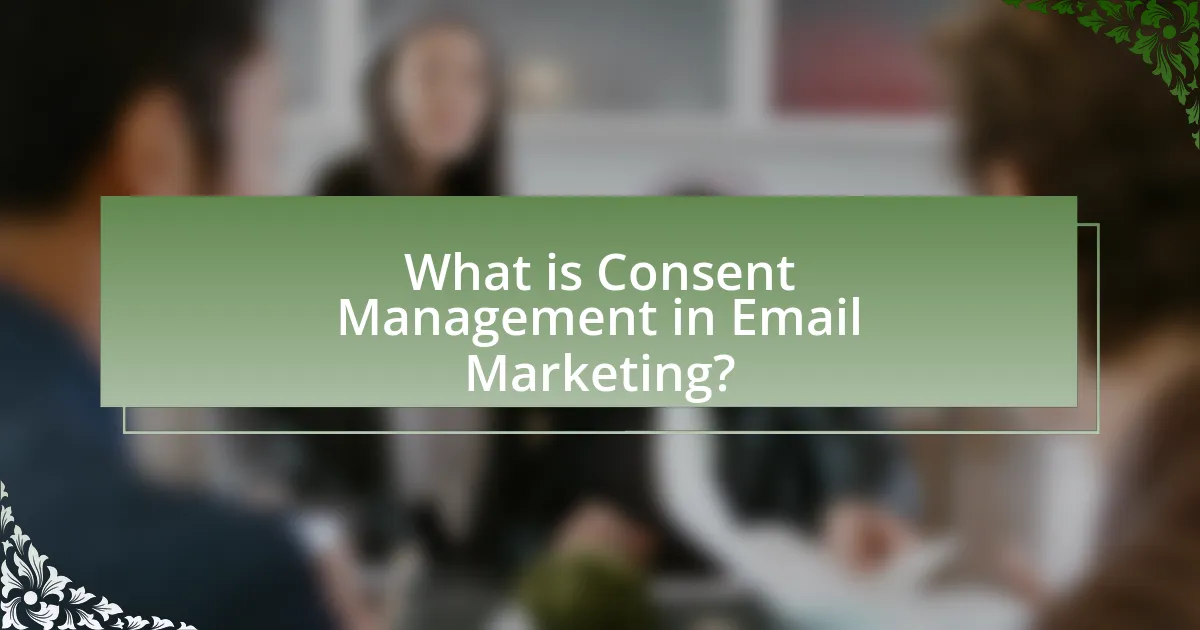
What is Consent Management in Email Marketing?
Consent management in email marketing refers to the process of obtaining, tracking, and managing the permissions of individuals to receive marketing communications. This practice ensures compliance with regulations such as the General Data Protection Regulation (GDPR) and the CAN-SPAM Act, which mandate that marketers must have explicit consent from recipients before sending promotional emails. Effective consent management involves clear communication about how personal data will be used, providing options for users to opt-in or opt-out, and maintaining records of consent to demonstrate compliance.
Why is Consent Management crucial for email marketing?
Consent management is crucial for email marketing because it ensures compliance with legal regulations and builds trust with consumers. By obtaining explicit permission from individuals before sending marketing emails, businesses adhere to laws such as the General Data Protection Regulation (GDPR) and the CAN-SPAM Act, which mandate that recipients must opt-in to receive communications. Non-compliance can result in significant fines; for instance, GDPR violations can lead to penalties of up to 4% of a company’s annual global turnover. Furthermore, effective consent management enhances customer relationships, as consumers are more likely to engage with brands that respect their privacy and preferences, leading to higher open and conversion rates in email campaigns.
What are the legal implications of consent in email marketing?
The legal implications of consent in email marketing primarily revolve around compliance with regulations such as the General Data Protection Regulation (GDPR) and the CAN-SPAM Act. Under GDPR, obtaining explicit consent from individuals before sending marketing emails is mandatory, and failure to do so can result in significant fines, up to 4% of annual global turnover or €20 million, whichever is higher. The CAN-SPAM Act requires marketers to provide a clear opt-out option and prohibits deceptive subject lines, with violations leading to penalties of up to $43,792 per email. Therefore, ensuring proper consent management is crucial for legal compliance and avoiding financial repercussions in email marketing.
How does consent management enhance customer trust?
Consent management enhances customer trust by ensuring transparency and control over personal data usage. When businesses implement effective consent management practices, they allow customers to understand what data is being collected, how it will be used, and the ability to withdraw consent at any time. This transparency fosters a sense of security among customers, as evidenced by a study from the International Association of Privacy Professionals, which found that 80% of consumers are more likely to trust companies that clearly communicate their data practices. By prioritizing consent management, organizations not only comply with regulations like GDPR but also build stronger relationships with their customers based on trust and respect for their privacy.
What are the key components of effective consent management?
The key components of effective consent management include transparency, user control, documentation, and compliance with regulations. Transparency ensures that users are informed about what data is being collected and how it will be used, fostering trust. User control allows individuals to easily give, withdraw, or modify their consent, enhancing their autonomy over personal information. Documentation involves maintaining accurate records of consent to demonstrate compliance and accountability. Compliance with regulations, such as the General Data Protection Regulation (GDPR), mandates that organizations adhere to legal standards for obtaining and managing consent, thereby protecting user rights and minimizing legal risks.
How do opt-in and opt-out mechanisms work?
Opt-in and opt-out mechanisms are processes that allow individuals to give or withdraw consent for receiving communications, particularly in email marketing. In an opt-in system, users must actively provide their consent, typically by checking a box or signing up, before receiving marketing emails. This approach ensures that only interested individuals receive communications, thereby enhancing engagement and compliance with regulations like GDPR. Conversely, an opt-out mechanism allows users to receive communications by default but provides them the option to unsubscribe or withdraw consent at any time. This method can lead to higher initial subscription rates but may result in lower engagement if recipients are not genuinely interested. Both mechanisms are crucial for effective consent management, as they help businesses maintain compliance with legal standards while fostering trust with their audience.
What role does transparency play in consent management?
Transparency is crucial in consent management as it builds trust between organizations and individuals regarding data usage. By clearly communicating how personal data will be collected, used, and shared, organizations empower individuals to make informed decisions about their consent. Research indicates that 81% of consumers feel they have little control over their personal data, highlighting the need for transparency to enhance user confidence and compliance with regulations like GDPR. This transparency not only fosters a positive relationship with customers but also mitigates legal risks associated with data privacy violations.
What challenges do marketers face in consent management?
Marketers face several challenges in consent management, primarily related to compliance with regulations, consumer trust, and technological integration. Compliance with laws such as the General Data Protection Regulation (GDPR) and the California Consumer Privacy Act (CCPA) requires marketers to implement stringent processes for obtaining and managing consent, which can be complex and resource-intensive. Additionally, building and maintaining consumer trust is crucial; if consumers feel their data is mishandled, they may withdraw consent or disengage from marketing efforts. Furthermore, integrating consent management systems with existing marketing technologies can pose technical difficulties, leading to inefficiencies and potential data breaches. These challenges highlight the need for marketers to adopt robust consent management strategies that align with legal requirements and consumer expectations.
How can data privacy regulations impact consent management?
Data privacy regulations significantly impact consent management by establishing legal frameworks that dictate how organizations must obtain, manage, and document user consent for data processing. For instance, the General Data Protection Regulation (GDPR) requires explicit consent from individuals before their personal data can be collected or processed, compelling businesses to implement clear and transparent consent mechanisms. This regulation mandates that consent must be freely given, specific, informed, and unambiguous, which directly influences how companies design their consent management systems. Additionally, non-compliance with these regulations can result in substantial fines, as evidenced by the European Data Protection Board’s enforcement actions, which have imposed penalties reaching millions of euros for violations. Thus, data privacy regulations shape the operational practices of consent management, ensuring that organizations prioritize user rights and data protection.
What are common pitfalls in managing consent?
Common pitfalls in managing consent include inadequate documentation, lack of clarity in consent requests, and failure to update consent records. Inadequate documentation can lead to disputes over whether consent was obtained, as seen in cases where organizations faced legal challenges due to insufficient proof of consent. Lack of clarity in consent requests often results in users not fully understanding what they are agreeing to, which can diminish trust and lead to higher opt-out rates. Additionally, failure to update consent records can result in sending communications to individuals who have withdrawn their consent, violating regulations such as the General Data Protection Regulation (GDPR) and potentially incurring significant fines.
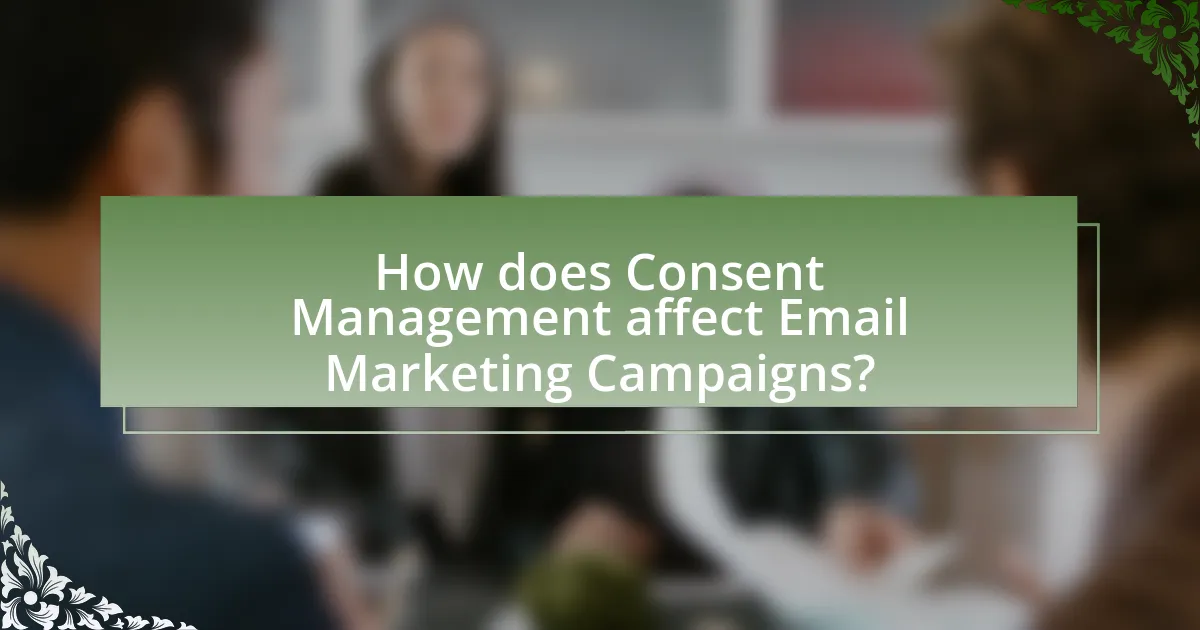
How does Consent Management affect Email Marketing Campaigns?
Consent management directly impacts email marketing campaigns by ensuring compliance with data protection regulations, such as GDPR and CCPA. These regulations require marketers to obtain explicit consent from users before sending promotional emails, which affects the size and quality of the email list. When consent is properly managed, marketers can build trust with their audience, leading to higher engagement rates and lower unsubscribe rates. According to a study by HubSpot, companies that prioritize consent management see a 20% increase in open rates and a 15% increase in click-through rates, demonstrating the positive correlation between consent management and campaign effectiveness.
What impact does consent management have on email deliverability?
Consent management significantly enhances email deliverability by ensuring that recipients have explicitly agreed to receive communications. When businesses implement effective consent management practices, they reduce the likelihood of emails being marked as spam, which directly influences sender reputation and inbox placement. According to a study by HubSpot, emails sent to recipients who have opted in have a 50% higher open rate compared to those sent without consent. This statistic underscores the importance of consent in maintaining a positive sender reputation, which is crucial for achieving high deliverability rates.
How can consent management improve engagement rates?
Consent management can improve engagement rates by ensuring that recipients receive communications they genuinely want, leading to higher open and click-through rates. When individuals provide explicit consent, they are more likely to engage with content, as they feel a sense of control and trust in the communication process. Research indicates that emails sent to opted-in subscribers have an average open rate of 20% higher than those sent to non-consenting recipients. This demonstrates that effective consent management not only fosters a positive relationship between brands and consumers but also enhances overall engagement metrics.
What are the consequences of poor consent management on campaigns?
Poor consent management on campaigns leads to legal repercussions, decreased customer trust, and reduced campaign effectiveness. When organizations fail to obtain proper consent, they risk violating data protection regulations such as the General Data Protection Regulation (GDPR), which can result in hefty fines. For instance, companies can face penalties up to €20 million or 4% of their global annual revenue, whichever is higher. Additionally, poor consent management can alienate customers, as individuals are less likely to engage with brands that misuse their data or send unsolicited communications. This disengagement ultimately results in lower open and click-through rates, diminishing the overall success of marketing campaigns.
How can businesses implement effective consent management strategies?
Businesses can implement effective consent management strategies by utilizing transparent opt-in processes and maintaining clear records of consent. This involves providing users with straightforward information about what they are consenting to, including the types of data collected and how it will be used. According to the General Data Protection Regulation (GDPR), organizations must ensure that consent is freely given, specific, informed, and unambiguous, which reinforces the need for clarity in communication. Additionally, businesses should regularly review and update their consent management practices to comply with evolving regulations and to ensure that users can easily withdraw consent at any time. This proactive approach not only builds trust with customers but also minimizes the risk of legal penalties associated with non-compliance.
What tools are available for managing consent in email marketing?
Tools available for managing consent in email marketing include Consent Management Platforms (CMPs) like OneTrust, TrustArc, and Cookiebot. These platforms help businesses collect, manage, and document user consent in compliance with regulations such as GDPR and CCPA. For instance, OneTrust offers features for tracking consent preferences and automating compliance workflows, ensuring that email marketers can effectively manage subscriber consent while adhering to legal requirements.
How can businesses educate customers about consent?
Businesses can educate customers about consent by implementing clear communication strategies that outline how personal data will be used. This includes providing straightforward privacy policies, utilizing consent forms that are easy to understand, and offering educational resources such as FAQs or webinars that explain the importance of consent in data handling. According to a study by the International Association of Privacy Professionals, 79% of consumers want to understand how their data is used, highlighting the necessity for businesses to prioritize transparency and clarity in their consent processes.

What are the best practices for Consent Management in Email Marketing?
The best practices for consent management in email marketing include obtaining explicit consent, providing clear information about data usage, and allowing easy withdrawal of consent. Explicit consent ensures that subscribers are fully aware of what they are agreeing to, which is supported by regulations like the General Data Protection Regulation (GDPR) that require clear affirmative action from individuals. Providing clear information about how their data will be used builds trust and transparency, which is essential for maintaining a positive relationship with subscribers. Additionally, allowing easy withdrawal of consent aligns with best practices and legal requirements, as it empowers individuals to control their personal information, thereby enhancing compliance and customer satisfaction.
What steps should businesses take to ensure compliance with consent regulations?
Businesses should implement a comprehensive consent management strategy to ensure compliance with consent regulations. This involves obtaining explicit consent from individuals before collecting their personal data, clearly informing them about how their data will be used, and providing an easy way for them to withdraw consent at any time. Additionally, businesses must maintain accurate records of consent and regularly review their practices to align with evolving regulations, such as the General Data Protection Regulation (GDPR) in Europe, which mandates that consent must be freely given, specific, informed, and unambiguous. Compliance can be further supported by conducting regular audits and training staff on data protection principles to mitigate risks associated with non-compliance.
How can businesses regularly audit their consent management processes?
Businesses can regularly audit their consent management processes by implementing a systematic review schedule, utilizing consent management software, and ensuring compliance with relevant regulations. Establishing a review schedule, such as quarterly audits, allows businesses to assess the effectiveness and accuracy of their consent records. Utilizing consent management software can streamline this process by providing automated tracking and reporting features, which help identify gaps or inconsistencies in consent data. Furthermore, ensuring compliance with regulations like the General Data Protection Regulation (GDPR) and the California Consumer Privacy Act (CCPA) is crucial; these laws mandate that businesses maintain clear records of consent and provide users with easy options to withdraw consent. Regular audits not only help in maintaining compliance but also enhance customer trust and engagement in email marketing efforts.
What role does customer feedback play in refining consent practices?
Customer feedback plays a crucial role in refining consent practices by providing insights into customer preferences and concerns regarding data usage. This feedback allows organizations to adjust their consent mechanisms to enhance transparency and user control, which are essential for building trust. For instance, a study by the Data & Marketing Association found that 78% of consumers are more likely to engage with brands that respect their privacy preferences. By actively incorporating customer feedback, companies can ensure that their consent practices align with user expectations, ultimately leading to improved customer satisfaction and compliance with regulations such as GDPR.
What practical tips can enhance consent management efforts?
To enhance consent management efforts in email marketing, organizations should implement clear and transparent consent forms that specify how personal data will be used. This approach builds trust and ensures compliance with regulations such as GDPR, which mandates explicit consent for data processing. Additionally, regularly updating consent records and providing easy opt-out options can improve user experience and maintain engagement. Research indicates that 88% of consumers are more likely to engage with brands that respect their privacy preferences, highlighting the importance of effective consent management strategies.
How can businesses create clear and concise consent forms?
Businesses can create clear and concise consent forms by using straightforward language, clearly defining the purpose of data collection, and ensuring that the consent request is easily understandable. Research indicates that 70% of users prefer simple language in consent forms, which enhances comprehension and trust. Additionally, businesses should avoid legal jargon and provide specific examples of how the data will be used, which can increase transparency and user confidence. Implementing these practices not only aligns with regulations like GDPR but also fosters better customer relationships by respecting user autonomy and preferences.
What strategies can improve customer opt-in rates?
To improve customer opt-in rates, businesses should implement clear value propositions, utilize targeted incentives, and ensure easy sign-up processes. Clear value propositions communicate the benefits of opting in, such as exclusive offers or valuable content, which can increase interest. Targeted incentives, like discounts or freebies, can motivate potential customers to provide their consent. Additionally, simplifying the sign-up process by minimizing required fields and ensuring mobile compatibility can significantly enhance user experience, leading to higher opt-in rates. Research indicates that companies with clear value propositions see up to a 30% increase in opt-in rates, demonstrating the effectiveness of these strategies.
